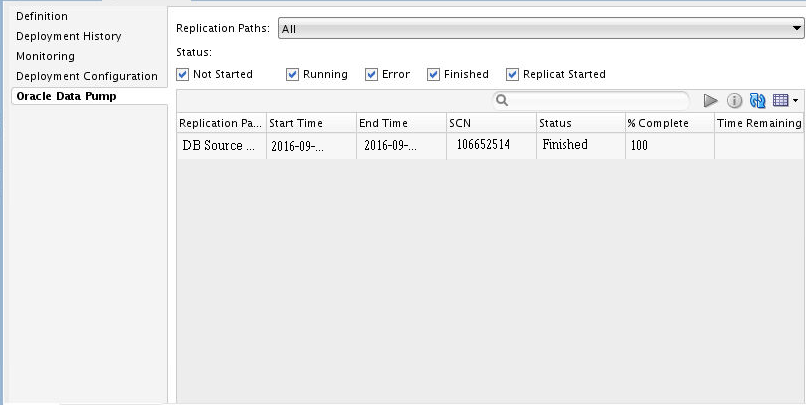5.2 Overview
This tab is used to edit information regarding the name and description of the deployment profile, deployment history, and deployment configuration.
5.2.1 Definition
Use this tab to edit high level details of the deployment profile. The available fields are:
-
Deployment Profile Name: You can view and edit the name of the deployment profile.
-
Description: You can add or edit the description of the deployment profile.
5.2.2 Deployment History
It provides a historical record of past deployments for a project, solution, deployment, or a single deployment profile.You can use the Select Columns icon in the table's toolbar to tailor your view of the deployment history information. Columns can be re-ordered as per requirement.
The available columns are:
-
Last Deployed
-
Deployment Status
-
Deployed By
-
Comments
-
Process Name
-
Process Type
-
Instance Name
5.2.3 Monitoring
Detailed information on the status of every process can be viewed under Monitoring. Additionally, you can monitor the status of each process currently deployed on an Oracle GoldenGate instance, such as the status, type, and mode of processes.
The tab looks as follows:
Figure 5-1 Monitoring Tab

The available columns are:
-
Status
-
Process Name
-
Type
-
Last Operation Lag
-
Mode
-
last Operation Timestamp
-
last Checkpoint Timestamp
-
Total Inserts
-
Total Deletes
-
Total Updates
-
Working Directory
-
Start Time
-
End of File
-
Total Ignores
-
Total Truncates
-
Total Executed DDLs
-
Total Discards
-
Total Operations
-
Input Checkpoint
-
Output Checkpoint
5.2.4 Deployment Configuration
Use this tab to view or edit the deployment options and physical resources.
You use the Deployment Settings check boxes to control which processes to start automatically. The following settings can be configured:
Deployment Settings
-
Start All GoldenGate Processes: Select this check box to start the Capture, Pump, and Apply processes.
-
Start Pump Processes: Select this check box to start the Pump processes.
-
Start Apply Processes: Select this check box to start the Apply processes.
Initial Load Settings
-
Oracle GoldenGate: Select this check box to start the Oracle GoldenGate initial load process.
-
Oracle Data Pump: Select this check box to start the Oracle Data Pump initial load process.
If you select the Start process in deployment configuration screen, then the Change Data Capture (CDC) process will start automatically at the successful completion of Oracle Data Pump Initial Load. If you do not select the Start process in deployment configuration screen, then the CDC process will not start automatically at the successful completion of Oracle Data Pump Initial Load.
If Oracle GoldenGate Studio is closed before the automatic start of CDC process, then the CDC process will not start automatically. You can start the CDC process manually using System Change Number (SCN), or starting the CDC process manually from the monitoring screen. The SCN increments by one with every commit.
You can add the Remote Link (network link) and Parallelism in this dialog. By default, parallelism is set to one.
5.2.5 Oracle Data Pump
Oracle GoldenGate Studio uses the Oracle Data Pump API for the initial load. Oracle Data Pump API can transfer data using different methods. In Oracle GoldenGate Studio, the IMPORT of data using flashback SCN is used. The Remote Link (network link) is used to access the source Database.
During Online Deployment with Oracle Data Pump Initial Load , Oracle GoldenGate Studio starts a PL/SQL procedure in the target database. This PL/SQL block invokes Oracle Data Pump job, providing it with Database Link to copy the data from source, SCN of source database, number of parallel threads to be launched, and log filename to log its activity. You have to provide the Database Link and Parallel values in the configuration screen while SCN of source database and log file name are provided by Oracle GoldenGate Studio. Oracle GoldenGate Studio also assumes DATA_PUMP_DIR directory to be created in target database, as this directory is used to create the log file. Oracle Data Pump table shows the current state of the Oracle Data Pump job. You can click on View Activity Log to view the content of the ODP Job OGG_LOG log file.
In parallel , CDC captures and replicat processes are deployed in Oracle GoldenGate. The capture processes are started to capture the online transactions while Oracle Data Pump is progressing. Oracle GoldenGate Studio waits for Oracle Data Pump job to complete. After completion of the Oracle Data Pump job, if Start Replicat option was selected, Oracle GoldenGate Studio starts the replicat processes with the related SCN number shown in the Oracle Data Pump page of the particular process. If not, you have to manually start the process by clicking on Start CDC Replicat in the Oracle Data Pump window.
If you shut down Oracle GoldenGate Studio after completion of Deployment in Oracle GoldenGate but before Oracle Data Pump job is complete, you have to manually starts the Replicat by clicking on Start CDC Replicat in the Oracle Data Pump page or Start with.. using the SCN shown in Oracle Data Pump page.
You can select the Replication Paths from the drop-down list and the status as Not Started, Running, Error, Finished, and Replicat Started. The status is displayed in tabular format. You can also use the toolbar to search, start the CDC Replicat, view the activity log, refresh table, and add or remove additional table columns.
The following table columns are displayed by default:
-
Replication Paths
-
Start Time
-
End Time
-
SCN
-
Status
-
% Complete
-
Time Remaining
The Time Remaining column can be empty when Oracle Data Pump is running. This is not related to the normal functioning of the product.
The Oracle Data Pump window looks as follows:
